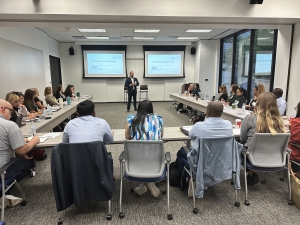 Employees and executives agree that productivity has improved during the prolonged work-from-home period, but companies must accurately measure productivity and take steps to make sure it’s sustainable, Bob Gruman, PwC, told attendees during the third session of the Council’s Post-Pandemic Workforce Series.
Employees and executives agree that productivity has improved during the prolonged work-from-home period, but companies must accurately measure productivity and take steps to make sure it’s sustainable, Bob Gruman, PwC, told attendees during the third session of the Council’s Post-Pandemic Workforce Series.
PwC research found that 34% of employees say they’re more productive now than they were before the pandemic, up from 28% in June. More than half of executives (52%) say average employee productivity has improved vs. 44% in June.
“Employees who report higher productivity are likely to say their companies have been better at specific activities. This includes collaborating on new projects and serving customers.”
Bob Gruman, PwC
Some 94% of employers said productivity is the same or higher than it was before the pandemic, according to PwC’s U.S. Remote Work Survey. To be more productive while working remotely, the top need for employees was greater flexibility in work hours. In the survey, 57% of executives said they plan to provide this.
Gruman cautioned against pushing for ever-increasing productivity because it could become unsustainable.
“We can continue to drive productivity,” Gruman said. “But provide an environment that people feel like they’re contributing and it’s not leading to burnout.”
Gruman identified six pillars that comprise successful remote work policies:
- Collaboration — Working with colleagues and clients to co-create or refine content
- Creation — Time spent crafting content, driving analysis and doing research
- Communication — Exchanging information, advising and negotiating with others
- Coaching — Leading and driving teams, motivating others, developing team members
- Community — Socializing with the team, building a sense of community, nurturing relationships
- Commitment — Agreeing to action, inspiring others to act
According to Gruman, best practices for achieving sustainable productivity with remote workers include:
- Model the way — Lead by example, Gruman advised. Managers should check in with employees on mental health and well-being and invest in their own well-being. “Be vulnerable,” Gruman said. “Create a culture of openness and flexibility.”
- Lead with inclusion — Implement round-robins to hear from everyone in a meeting, identify mentors and sponsors to help diverse employees build virtual professional networks, and use video for hybrid meetings with in-office employees logging in from their own desks.
- Evolve digital meetings — Prepare attendees in advance with objectives for meetings. “Don’t be afraid to experiment with different methods of facilitation including gamification and breakouts,” Gruman said. “Make time for relationship building, which is critical to team cohesion. And keep all content digital to give all hybrid employees equal access.”
Post-Pandemic Workforce Series
Kevin Broom, Director Communications and Research, writes about the Council’s sector-specific best practices and leadership. Click here to subscribe to the Council’s newsletter, which highlights industry practices, workforce development, Council activities and more.




